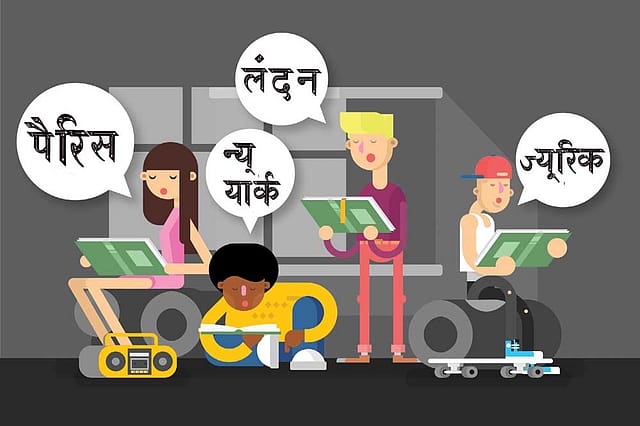Hindi As a Foreign Language

THE LAST THING that Zareen Azad expected to find at Delhi University were groups of students protesting against a compulsory Hindi course to be taken by those who hadn’t studied the language in school. Having taken an 18-hour journey from Damascus, Syria, to Delhi to enroll for a Hindi certificate course at the university, the 19-year-old found it difficult to believe that there was anyone who couldn’t see the value of learning the language.
“I first heard Hindi when watching Bollywood films at Phoenix High School in London where I studied as a child. My sister is here in India already, married to an Indian. I want to move here too. It seemed a natural choice to opt for a Hindi language course to make the transition easier and more fruitful for me. I want to eventually pursue my post graduation and find a job here as well,” says Azad, who arrived here two weeks ago on October 23rd, so that she would have a week to settle down as well as get a chance to experience Diwali celebrations. “I spent Diwali night with some others who were learning Hindi at Delhi University and through Zabaan language classes. It was my first chance to practise the little Hindi that I already know. There was something about the words, the lights, the joy and the food that made that night magical for all of us. I have been looking forward to studying Hindi for the last one year,” she adds.
She’s not the only one eager to pick up the language. This year, certificate and diploma courses in Hindi saw a 25 per cent increase in takers, many of whom were foreigners and Persons of Indian Origin (PIOs). “We have always had students from all over the world keen on studying Hindi. Now we’re noticing interest from new countries such as Mongolia, China, Canada and those in the Middle East. This admission season, we’ve noticed a spurt in the number of PIOs applying for courses. We feel it’s partly because of the current Government’s attempt to reach out to the Indian diaspora,” says Amrit Kaur, deputy dean of foreign students, Delhi University.
The individual reasons for opting for Hindi vary greatly from the official ones. Jack Dachler is a Canadian who moved to Delhi a year ago to fall in love. His choice of Hindi at Delhi University was just so that he could write and talk to women in the city. “My first girlfriend was Indian and even though that relationship didn’t work out, I know in my heart that an Indian woman is the one for me,” he says. Yucee Onwuachimba, a Nigerian who is living in Mumbai and pursuing a distance- learning course in Hindi from IGNOU, says she only opted for the language to be able to get a good job in the city. For Meredy Zorhn, an American culinary graduate in Delhi, also pursuing Hindi at IGNOU, the course is her key to deciphering ancient Indian recipes and old family cookbooks.
“The global interest in Hindi today is directly related to the global interest in India. Foreigners want to come here to work, study, learn new skills and even make new friends. If you know Hindi, an entire new world opens up, as with any other language. Like it or not, it is the most widely spoken language in the country. For those who wish to study or live here—for whatever reason—learning Hindi has to be the natural course of action,” says Ali Taqi, the founder of Zabaan Institute in Delhi. Born in Chicago, Taqi returned to India to set up Zabaan in 2009. Today the centre offers training through private offline tuitions and online courses in not just Hindi but Pashto, Urdu and Braj Bhasha as well. “As the world becomes more interconnected and travel becomes easier and easier, language becomes all the more important because in order to really experience a place, to absorb its culture and ethos, one first has to be able to communicate,” says Taqi.
The way in which Hindi is taught today has also contributed to its newfound popularity. State universities now offer certificates with practice sessions included, giving students a chance to not just learn theory but to put their learning to test through after-class get togethers, trips to villages and meetings with local communities. “I’ve tried learning Mandarin before in Beijing and what I found difficult was that the course focused on classroom learning. In Delhi, I’ve managed to find some local foreigner meet-up groups for practicing Hindi. This makes all the difference because when you are speaking to a native, that’s when you’ll really gain confidence,” says Zorhn.
A few months ago, University of Montana in Washington became the fourth in the US to constitute a Hindi language class. Closer to home, the Atal Bihari Vajpayee Hindi Vishwavidyalaya in Bhopal started the country’s first engineering course in Hindi a month ago. With an average of 20-30 seats available for Hindi at most public universities, a crunch of professors in the subject and a backlash by students from non-Hindi speaking cities, the language still has plenty of evolving to do.
